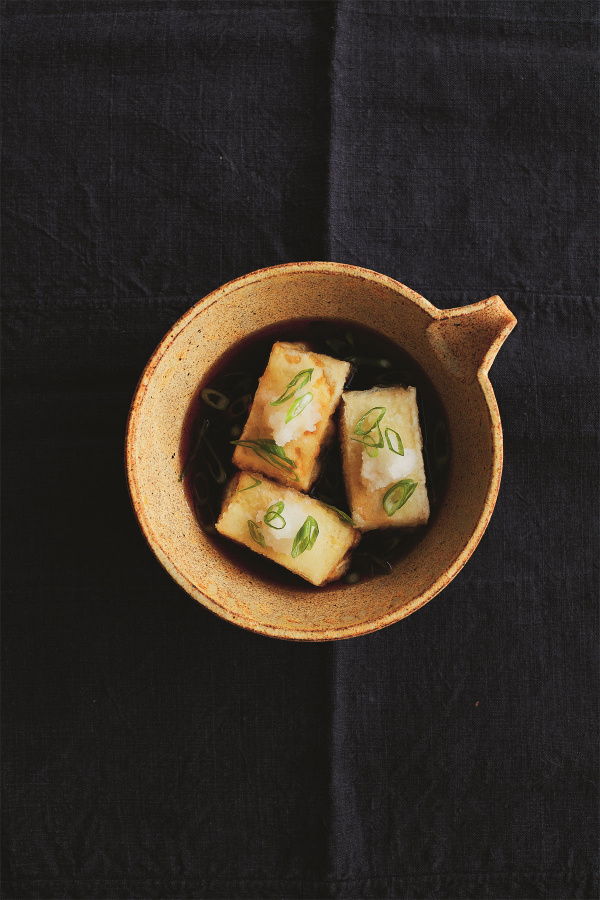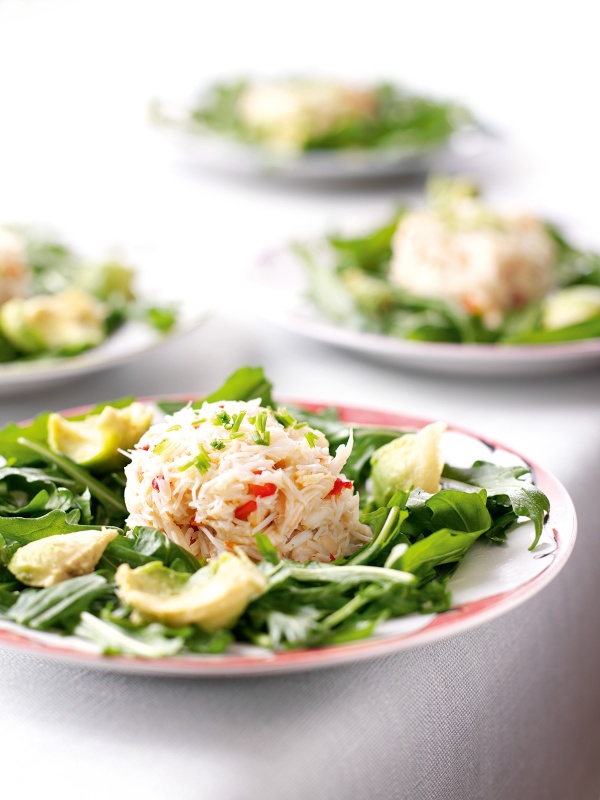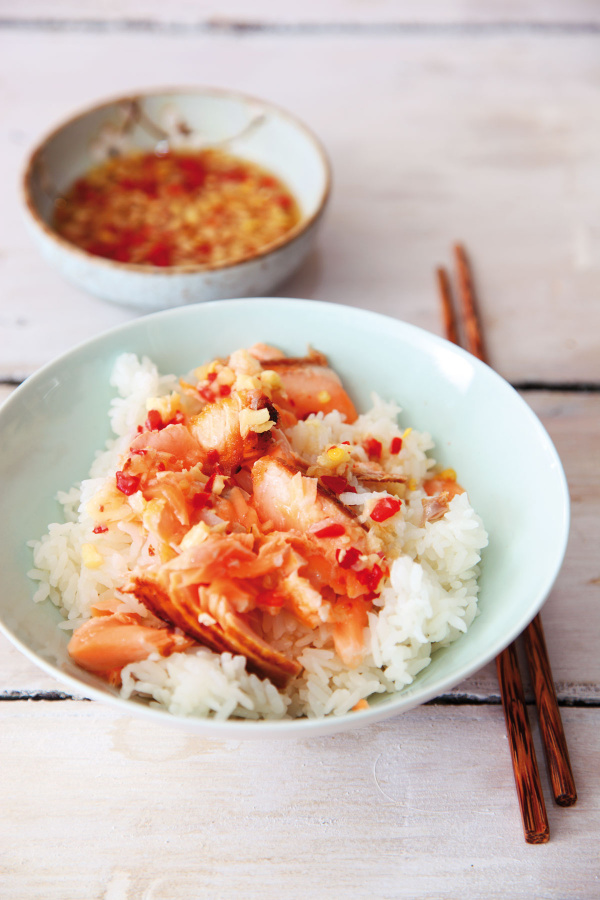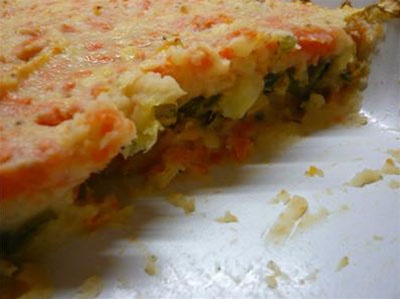Agedashi Tofu
by Bonnie Chung, featured in Tofu Tasty Published by Pavilion BooksIntroduction
I would not dream of eating in an izayaka (Japanese pub) and not ordering this dish. For me, it is compulsory. Outside Japan, I still find excuses to order it, or, even better, to make it at home. Agedashi tofu is essentially a crispy deep-fried tofu, served in a seasoned soy-based sauce, with grated radish and toppings such as spring onions and bonito flakes. If you don’t mind deep-frying at home, this is a quick and easy starter or side dish, and incredibly easy to get right.
I would not dream of eating in an izayaka (Japanese pub) and not ordering this dish. For me, it is compulsory. Outside Japan, I still find excuses to order it, or, even better, to make it at home. Agedashi tofu is essentially a crispy deep-fried tofu, served in a seasoned soy-based sauce, with grated radish and toppings such as spring onions and bonito flakes. If you don’t mind deep-frying at home, this is a quick and easy starter or side dish, and incredibly easy to get right.

Share or save this
Ingredients
Serves: 4 (as a starter)
For the dashi
- 10 grams kombu (dried kelp)
- 1 litre filtered or soft water
- 30 grams dried shiitake mushrooms
For the agedashi tofu
- 500 millilitres dashi stock
- 5 tablespoons light soy sauce
- 5 tablespoons mirin
- 400 grams soft or silken tofu (drained for 20 minutes)
- 6 tablespoons cornflour
- vegetable oil (for deep-frying)
- 2 spring onions (finely sliced)
- 1 tablespoon grated daikon radish to serve (optional)
For the dashi
- ¼ ounce kombu (dried kelp)
- 4 cups filtered or soft water
- 1 ounce dried shiitake mushrooms
For the agedashi tofu
- 2 generous cups dashi broth
- 5 tablespoons light soy sauce
- 5 tablespoons mirin
- 14 ounces soft or silken tofu (drained for 20 minutes)
- 6 tablespoons cornstarch
- vegetable oil (for deep-frying)
- 2 scallions (finely sliced)
- 1 tablespoon grated daikon radish to serve (optional)
Method
Agedashi Tofu is a guest recipe by Bonnie Chung so we are not able to answer questions regarding this recipe
For the dashi
- Kombu comes in large sheets that require cutting down to size. Once you have weighed the amount of kombu that you need, I recommend that you make some extra cuts into the pieces with scissors to increase the surface area and help the flavour to release into the water.
- Pour the measured filtered water into a large bowl or saucepan and add the kombu and shiitake mushrooms. Cover with clingfilm (plastic wrap) or a lid and leave for at least 2 hours or overnight.
- Pour the mixture into a saucepan, if it is not already in one, and remove the mushrooms. Simmer over a medium-low heat until just before boiling, then remove the kombu. It is really important that you don't boil the kombu, or it loses its delicate flavours. My friend Tim Anderson, of Nanban Japanese restaurant in London, recommends toasting kombu over an open flame for a deeper flavour before soaking it.
- The dashi can be kept in the refrigerator, covered, or in a closed bottle, for 3 days, or in the freezer for up to 2 months.
For the agedashi tofu
- Prepare the sauce by mixing the dashi, soy sauce and mirin together in a bowl.
- Next, slice the tofu into 4 x 100g/3½ oz blocks and coat the pieces in the cornflour.
- Fill a large saucepan or wok with enough oil to sit at least 2cm/¾ inch deep and heat it up for 3–4 minutes. As always when deep-frying, be very careful and do not leave the kitchen or take a telephone call.
- Drop 2 of the tofu blocks into the oil; they should sizzle immediately. If they don’t, the oil is not hot enough. Fry for 3–4 minutes until lightly golden brown, then lift out onto kitchen paper (paper towels) to drain off the excess oil. Fry the remaining 2 pieces in the same way before serving up into bowls.
- Divide the sauce between the bowls, pouring it around the tofu, not on top of it.
- Scatter with spring onions and grated daikon to serve.
For the dashi
- Kombu comes in large sheets that require cutting down to size. Once you have weighed the amount of kombu that you need, I recommend that you make some extra cuts into the pieces with scissors to increase the surface area and help the flavour to release into the water.
- Pour the measured filtered water into a large bowl or saucepan and add the kombu and shiitake mushrooms. Cover with clingfilm (plastic wrap) or a lid and leave for at least 2 hours or overnight.
- Pour the mixture into a saucepan, if it is not already in one, and remove the mushrooms. Simmer over a medium-low heat until just before boiling, then remove the kombu. It is really important that you don't boil the kombu, or it loses its delicate flavours. My friend Tim Anderson, of Nanban Japanese restaurant in London, recommends toasting kombu over an open flame for a deeper flavour before soaking it.
- The dashi can be kept in the refrigerator, covered, or in a closed bottle, for 3 days, or in the freezer for up to 2 months.
For the agedashi tofu
- Prepare the sauce by mixing the dashi, soy sauce and mirin together in a bowl.
- Next, slice the tofu into 4 x 100g/3½ oz blocks and coat the pieces in the cornstarch.
- Fill a large saucepan or wok with enough oil to sit at least 2cm/¾ inch deep and heat it up for 3–4 minutes. As always when deep-frying, be very careful and do not leave the kitchen or take a telephone call.
- Drop 2 of the tofu blocks into the oil; they should sizzle immediately. If they don’t, the oil is not hot enough. Fry for 3–4 minutes until lightly golden brown, then lift out onto kitchen paper (paper towels) to drain off the excess oil. Fry the remaining 2 pieces in the same way before serving up into bowls.
- Divide the sauce between the bowls, pouring it around the tofu, not on top of it.
- Scatter with scallions and grated daikon to serve.
Additional Information
DASHI:
Vegetarian Japanese stock is great to have on hand for enhancing many of the dishes in this book. It is a great swap in Asian food for classic vegetable stock for many reasons, but mostly because vegetable stock is based on a French mirepoix of ingredients, including quite distinctive flavours such as garlic and celery, which in some more subtle dishes - including miso soup - are too intrusive. There is also the advantage of not having added salt, which is in most instant vegetable stocks, so you can better control the seasoning of your dish.
There are a few ways to make dashi, but the most common uses kombu, a Japanese kelp. You can buy packs of dried powdered kombudashi from Asian stores or online; I always have packets at home if I don't have time to make dashi.
DRAINING FRESH TOFU:
Fresh tofu is normally sold in a tray of water that keeps it moist and fresh, but usually you do not want all that extra liquid in the finished dish. So, for all dishes using fresh tofu, draining is required.
Simply place the tofu in a fine-meshed sieve over a sink to drain off the excess water.
DASHI:
Vegetarian Japanese stock is great to have on hand for enhancing many of the dishes in this book. It is a great swap in Asian food for classic vegetable stock for many reasons, but mostly because vegetable stock is based on a French mirepoix of ingredients, including quite distinctive flavours such as garlic and celery, which in some more subtle dishes - including miso soup - are too intrusive. There is also the advantage of not having added salt, which is in most instant vegetable stocks, so you can better control the seasoning of your dish.
There are a few ways to make dashi, but the most common uses kombu, a Japanese kelp. You can buy packs of dried powdered kombudashi from Asian stores or online; I always have packets at home if I don't have time to make dashi.
DRAINING FRESH TOFU:
Fresh tofu is normally sold in a tray of water that keeps it moist and fresh, but usually you do not want all that extra liquid in the finished dish. So, for all dishes using fresh tofu, draining is required.
Simply place the tofu in a fine-meshed sieve over a sink to drain off the excess water.






Tell us what you think
Thank you {% member.data['first-name'] %}.
Explore more recipesYour comment has been submitted.